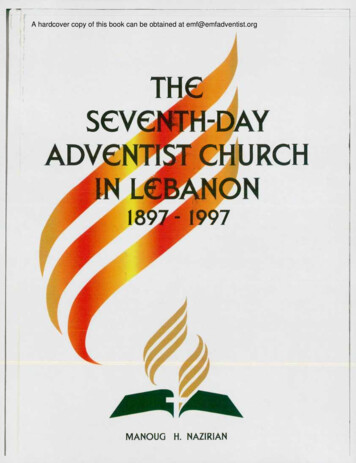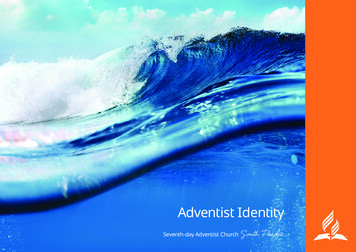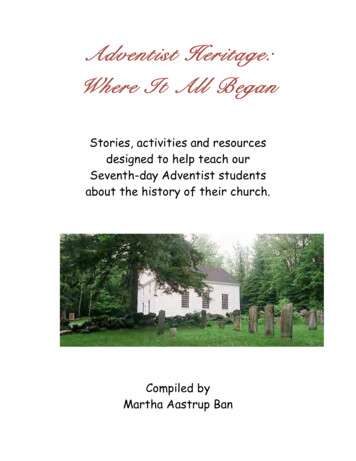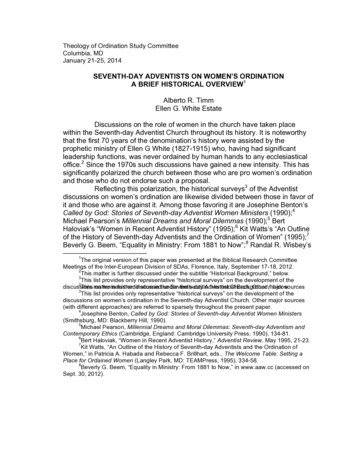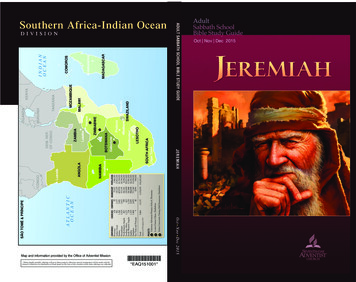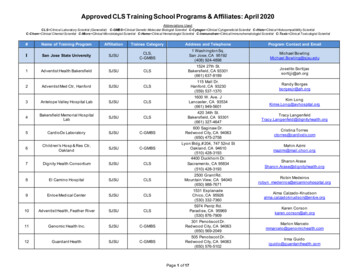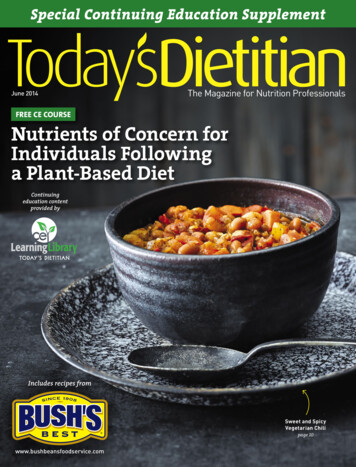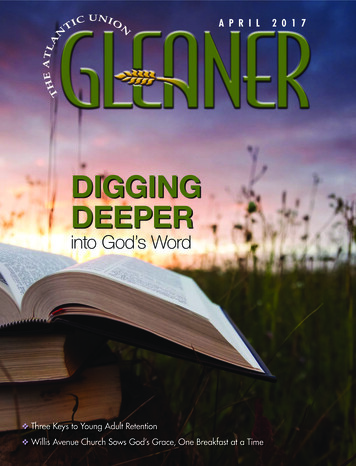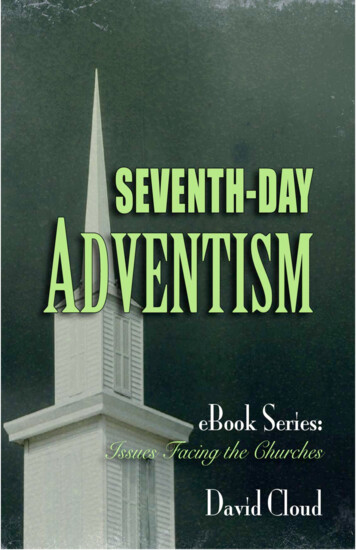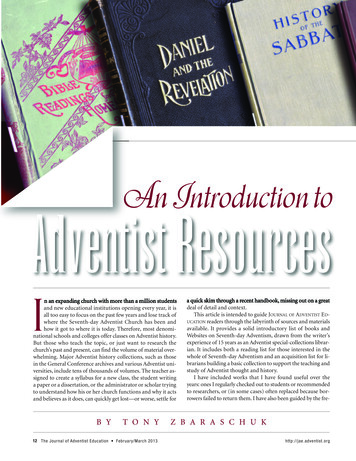
Transcription
An Introduction toAdventist ResourcesIn an expanding church with more than a million studentsand new educational institutions opening every year, it isall too easy to focus on the past few years and lose track ofwhere the Seventh-day Adventist Church has been andhow it got to where it is today. Therefore, most denominational schools and colleges offer classes on Adventist history.But those who teach the topic, or just want to research thechurch’s past and present, can find the volume of material overwhelming. Major Adventist history collections, such as thosein the General Conference archives and various Adventist universities, include tens of thousands of volumes. The teacher assigned to create a syllabus for a new class, the student writinga paper or a dissertation, or the administrator or scholar tryingto understand how his or her church functions and why it actsand believes as it does, can quickly get lost—or worse, settle forB YT O N Y12 The Journal of Adventist Education February/March 2013a quick skim through a recent handbook, missing out on a greatdeal of detail and context.This article is intended to guide JOURNAL OF ADVENTIST EDUCATION readers through the labyrinth of sources and materialsavailable. It provides a solid introductory list of books andWebsites on Seventh-day Adventism, drawn from the writer’sexperience of 15 years as an Adventist special-collections librarian. It includes both a reading list for those interested in thewhole of Seventh-day Adventism and an acquisition list for librarians building a basic collection to support the teaching andstudy of Adventist thought and history.I have included works that I have found useful over theyears: ones I regularly checked out to students or recommendedto researchers, or (in some cases) often replaced because borrowers failed to return them. I have also been guided by the fre-Z B A R A S C H U Khttp://jae.adventist.org
quency of reprints, by consultation with other Adventist facultyand librarians, and by the use and opinion of scholars in thefield. The list has been reviewed by several experts in the field,including the director of the General Conference Office ofArchives, Statistics, and Research.Librarians have an 80-20 rule—20 percent of the sources inany collection do 80 percent of the work.* Since this is a recursive relationship, this means that a collection 1/25 the size of amajor library (4 percent, or 20 percent of 20 percent) can doalmost two-thirds of the work (64 percent, or 80 percent of 80percent). Librarians supporting classes in Adventist historyshould take note.It will be immediately obvious to specialists in every fieldthat their own area has been sadly shortchanged. Due to spacelimitations, I have ruthlessly omitted articles, dissertations, anda great number of books about one particular topic, or country,or institution in favor of those that cover Adventism as a whole.I have completely neglected the specialized (and fascinating)field of Adventist hymnology. I have also restricted myself toworks in English. This list does not provide a complete library,but rather an introduction to a century and a half of Adventistthought and practice throughout the world, as well as booksabout Adventism. At the end are suggestions for those wishingto explore further.General Reference WorksThe Seventh-day Adventist Encyclopedia (2 vols., Review &Herald [henceforth R&H], 1996) is a basic, necessary resource,listing most of the church’s ideas, institutions, and people. Itdoes not include people living as of its publication date, however. You will also want to obtain Gary Land’s Historical Dictionary of Seventh-day Adventism (Scarecrow, 2005; reprintedas The A to Z of the Seventh-day Adventists in 2009) for its excellent bibliography and more recent articles. The Church Manual, the Seventh-day Adventist Minister’s Handbook, the AnnualStatistical Report, and the Seventh-day Adventist Yearbook willbe useful for current church operation and contacts. Oldervolumes of all these, valuable for historical data, are availableonline at http://www.adventistarchives.org. Genealogists willhttp://jae.adventist.orgtreasure back issues of the Yearbook and the online Seventh-dayAdventist Obituary Index.Ellen G. WhiteThe complete works of the church’s co-founder are availablein many languages at the White Estate Website (http://egwwritings.org/). The two major biographies are Arthur L. White,Ellen G. White (6 vol., R&H, 1981) and Ron Numbers’ Prophetess of Health (3rd ed., Eerdmans, 2008), the latter focusing onher role in health reform. Although regarded as controversialwhen it first came out, this book still must be regarded as indispensable.Other useful books for understanding Ellen White’s thinking and contributions include D. A. Delafield’s Ellen G. Whitein Europe (R&H, 1975) and Herbert Douglass, Messenger of theLord (Pacific Press [henceforth PPPA], 1998). Gilbert Valentine’s The Struggle for the Prophetic Heritage (Institute Press,2006) and The Prophet and the Presidents (PPPA, 2011) arevaluable recent studies of Ellen White’s leadership and influence on the church.Walter Rea’s The White Lie (M & R Publications, 1982) iscontroversial and overwrought but needs to be read to understand the crisis in Adventist understandings of Ellen White inthe 1970s and 1980s. D. M. Canright’s Seventh-day AdventismRenounced (Revell, 1889) is probably the most important earlycriticism of Ellen White and Adventism, which continues to influence outside views of Adventism even today.1844 and the Millerite MovementThere is a large body of literature on the Millerite movementand the Great Disappointment. George Knight’s William Millerand the Rise of Adventism (PPPA, 2010) is the best history. Alsovaluable are David K. Rowe’s God’s Strange Work: WilliamMiller and the End of the World (Eerdmans, 2008) and the essaysin Ronald L. Numbers and Jonathan M. Butler (eds.), The Disappointed (Indiana University Press, 1987). Much useful background is provided by Jerome Clark’s 1844 (3 vol., SouthernPublishing Association [henceforth SPA], 1968) and EdwinGaustad’s The Rise of Adventism (Harper & Row, 1974). F. D.The Journal of Adventist Education February/March 201313
Nichol’s The Midnight Cry (R&H, 1944) is somewhat dated butstill useful.Indispensable primary sources are Sylvester Bliss’ Memoirsof William Miller (reprinted by Andrews University Press,2005), and Miller’s own Evidence From Scripture and History ofthe Second Coming of Christ About the Year 1843 (reprinted byLeaves-of-Autumn Books, 1988). Many important documentsare reprinted in George Knight’s 1844 and the Rise of Sabbatarian Adventism (R&H, 1994). Isaac Wellcome’s History of the Second Advent Message and Mission, Doctrine and People (1868,reprinted by Andrews University Press, 2008) is an inside history of the Millerite movement from outside what became theAdventist Church, and very valuable.Adventist HistoryGeorge Knight’s A Brief History of Seventh-day Adventists(R&H, 1999) and Mervyn Maxwell’s Tell It to the World (PPPA,1976) are good introductions, but should be backed up byRichard W. Schwarz and Floyd Greenleaf ’s Light Bearers (PPPA,revised and updated, 2000). The earliest comprehensive histories of Seventh-day Adventism are still worth reading. J. N.Loughborough’s The Great Second Advent Movement (reprintedby Adventist Pioneer Library, 1992) and Rise and Progress of theSeventh-day Adventists (reprinted by Leaves-of-Autumn Books,1988) contain much that is available nowhere else, as do W. A.Spicer’s Pioneer Days of the Advent Movement (R&H, 1941) andA. W. Spalding’s Origin and History of Seventh-day Adventists(4 vol., R&H, 1961). A.V. Olson’s Thirteen Crisis Years, 18881901 (R&H, 1981) covers the theological and organizationalcrises, and the resulting major transformations in Adventistthought and structure at the end of the 19th century.For global Adventism, start with George Knight’s edition ofHistorical Sketches of Foreign Missions (1886, reprinted by Andrews University Press, 2005), then continue with three collections of essays: Noel Clapman (ed.), Seventh-day Adventists inthe South Pacific (Signs Publishing Co., 1985); Gil Fernandez(ed.), Light Dawns Over Asia (AIIAS, 1990); and Hugh Dunton,Daniel Heinz, and Ronald Strasdowsky (eds.), Heirs of the Reformation: Seventh-day Adventists in Europe (Stanborough Press,14 The Journal of Adventist Education February/March 20131997). The essays in those three vary significantly in quality,but Floyd Greenleaf ’s A Land of Hope (Casa PublicadoraBrasileira, 2011) is authoritative for South America. There isunfortunately as yet no general history of Adventism in Africa,but Stefan Höschele’s Christian Remnant – African Folk Church:Seventh-day Adventism in Tanzania, 1903-1980 (Brill, 2007) isa work of deep scholarship with considerable implications beyond just Tanzania or the African continent. For American Adventism, long the center of the church and still influential, GaryLand’s Adventism in America (Andrews University Press, 1998);and Malcolm Bull and Keith Lockhart’s Seeking a Sanctuary(2nd ed., Indiana University Press, 2007) are both valuable.There are too many good books on Adventism in individualcountries to list, but the Seventh-day Adventist Encyclopedia hasan article for each country with an Adventist presence, and CiroSepulveda’s On the Margins of Empires (Oakwood College Press,2007) is an interesting presentation about Adventism in developing countries.George Knight’s Organizing to Beat the Devil (R&H, 2001)provides a useful guide to the origin and purposes of the presentstructure of the Seventh-day Adventist denomination. P. GerardDamsteegt’s Foundations of the Seventh-day Adventist Messageand Mission (Eerdmans, 1977) and Barry Oliver’s SDA Organizational Structure: Past, Present, and Future (Andrews UniversityPress, 1989) are essential follow-ups on the same topic.Systematic Adventist TheologyA great deal of Adventist theology is topical, and it can bedifficult to get a sense of the movement as a whole. GeorgeKnight’s A Search for Identity (R&H, 2000) gives a useful sketchof how Adventist beliefs developed. More detail can be seen inKnight’s collection Earliest Seventh-day Adventist Periodicals(Andrews University Press, 2005) and James White and UriahSmith’s The Biblical Institute (1878, reprinted by TEACH Services, 2005), along with Bible Readings for the Home Circle (R&H,1917), one of the most-frequently reprinted books in the history of the denomination.Later systematic presentations include the proceedings ofthe 1953 Bible conference, Our Firm Foundation (2 vol., R&H,http://jae.adventist.org
1953), the Seventh-day Adventist Bible Commentary (7 vol.,R&H, 1976), Richard Rice’s The Reign of God (Andrews University Press, 1997), the Handbook of Seventh-day AdventistTheology (R&H, 2000), and Seventh-day Adventists Believe(Ministerial Association, 2005).For relations with evangelicals, see the revised annotatededition of Seventh-day Adventists Answer Questions on Doctrine(Andrews University Press, 2003), which corrects a number ofmisrepresentations in the 1957 edition. Reinder Bruinsma’sSeventh-day Adventist Attitudes Toward Roman Catholicism,1844-1965 (Andrews University Press, 2004) provides a goodsummary of this subject. Jonquil Hole and Børge Schantz’s TheThree Angels and the Crescent (SDA Global Centre for IslamicStudies, 1993) is very useful for information about AdventistMuslim relations.Topical TheologyThe standard Adventist work on biblical prophecy for manyyears, and still in print, is Uriah Smith’s The Prophecies of Danieland Revelation (R&H, 1944; but compare with a pre-1944 edition in some areas). Leroy Edwin Froom’s comprehensive TheProphetic Faith of Our Fathers (4 vols., R&H, 1946-1954, especially volume 4) covers the history of Adventist prophetic interpretation. You will also want Roy Allan Anderson’s Unfoldingthe Revelation (PPPA, 1974), Desmond Ford’s Daniel (SPA,1978), and Mervyn Maxwell’s God Cares (2 vol., PPPA, 1981)for a sampling of more recent Adventist approaches.Three important books on the Sabbath: J. N. Andrews’ History of the Sabbath and First Day of the Week (R&H, 1912),Samuele Bacchiochi’s From Sabbath to Sunday (Pontifical Gregorian University, 1977), and Sigve Tonstad’s The Lost Meaningof the Seventh Day (Andrews University Press, 2009). Mostother Adventist books just re-package information from thefirst two.On the topics of God and salvation, classic Adventist presentations include A. G. Daniells’ Christ Our Righteousness(Ministerial Association, 1941), M. L. Andreasen’s The Sanctuary Service (R&H, 1969), and E. J. Waggoner’s The Glad Tidings(PPPA, 1978). Edward Heppenstall’s Our High Priest (R&H,http://jae.adventist.org1972), and The Man Who Is God (R&H, 1977) should be readalong with Eric Claude Webster’s Crosscurrents in AdventistChristology (Andrews University Press, 1992), J. R. Zurcher’sTouched With Our Feelings (R&H, 1999) and Woodrow W.Whidden II, Jerry Moon, and John W. Reeve’s The Trinity(R&H, 2002) for more recent looks at a topic that has oftenbeen a matter of agonized debate among Adventists. Also seeGeoffrey Paxton’s The Shaking of Adventism (Zenith, 1977) andJack Provonsha’s You Can Go Home Again (R&H, 1982).Important works on Adventism, the state, and civil disobedience are A. T. Jones’ The Two Republics (PPPA, 1892), F. M.Wilcox’s Seventh-day Adventists in Time of War (R&H, 1936),Douglas Morgan’s Adventism and the American Republic (University of Tennessee Press, 2001) and the documents reprintedin Morgan’s The Peacemaking Remnant (Adventist Peace Fellowship, 2005).Michael Pearson’s Millennial Dreams and Moral Dilemmas(Cambridge University Press, 1990) is a good historical introduction to Adventist ethics and the realm of practical theology.Alas, there are far too many books on individual topics of theChristian life (prayer, marriage, stewardship, and other topics)to list here.Leroy Edwin Froom’s The Conditionalist Faith of Our Fathers(2 vol., R&H, 1965) is still the best overall presentation of Adventist views on conditional immortality.Alden Thompson’s Inspiration (R&H, 1991) and Samuel Koranteng-Pipim’s Receiving the Word (Berean Books, 1996) represent two poles of Adventist thought about inspiration. Oneshould also look at Sakae Kubo and Walter Specht, So ManyVersions? (Zondervan, 1983) for a related topic.Important sociological studies include Roger L. Dudley’sWhy Our Teenagers Leave the Church (R&H, 2000) and BarryGane’s Youth Ministry and the Transmission of Beliefs and Values(Signs, 1997), along with the Valuegenesis reports, notablyRoger Dudley’s Valuegenesis: Faith in the Balance (La SierraUniversity Press, 1992) and V. Bailey Gillespie’s Valuegenesis:Ten Years Later (Hancock Center, 2004).Nancy Vyhmeister’s Women in Ministry (Andrews University Press, 1998) and V. Norskov Olsen’s Myth and Truth AboutThe Journal of Adventist Education February/March 201315
Church, Priesthood, and Ordination (Loma Linda UniversityPress, 1990) are both good introductions to a more recent topicof debate.There has been little scholarship on Adventism’s offshootssince Lowell Tarling’s hard-to-find The Edges of Seventh-dayAdventism (Galilee, 1981). One key recent work is KennethNewport’s The Branch Davidians of Waco (Oxford UniversityPress, 2006).EducationFloyd Greenleaf ’s In Passion for the World (PPPA, 2005) isthe best overall history of Adventist education. Maurice Hodgen’s School Bells & Gospel Trumpets (Adventist Heritage Publications, 1978) collects important primary documents fromearly Adventist education. Merlin Neff ’s For God and C.M.E.(PPPA, 1964), Ira Gish’s Madison, God’s Beautiful Farm: The E.A. Sutherland Story (PPPA, 1979), and Gilbert Valentine’s W.W.Prescott (R&H, 2005) cover major Adventist educators and theircontributions.Emmett K. Vande Vere’s The Wisdom Seekers (SPA, 1972)and Windows (SPA, 1975) are older but still offer valuable insight into the development of Adventist education.By far the best (albeit controversial) history of Adventistthought on geology and evolution is Ronald Numbers’ The Creationists (Harvard University Press, 2006).Health and MedicineThe two top introductions to Adventist medical history areRichard Schaefer’s Legacy (Legacy, 2005) on Loma Linda University, and Richard Schwarz’s John Harvey Kellogg, M.D.(R&H, 2006) on the early reformer and 19th-century Adventistmedicine. D. E. Robinson’s The Story of Our Health Message(SPA, 1965) is older but still valuable, as is Warren Johns andRichard Utt’s The Vision Bold (R&H, 1977).Important AdventistsJames White’s Life Incidents (Andrews University Press,2003) and The Autobiography of Elder Joseph Bates (SPA, 1970)deserve careful study, as do the best recent biographies of thesetwo founders of Adventism, Gerald Wheeler’s James White(R&H, 2003) and George Knight’s Joseph Bates (R&H, 2004).Knight’s From 1888 to Apostasy (R&H, 1987) covers the life andinfluence of A. T. Jones. On J. N. Andrews, see the essays inHarry Leonard (ed.), J. N. Andrews: The Man and the Mission(Andrews University Press, 1985). Robert Edwards’ H.M.S.Richards (R&H, 1998) is a serviceable biography of Adventism’sforemost evangelist.Douglas Morgan’s Lewis C. Sheafe: Apostle to Black America(R&H, 2010) reopens a neglected chapter of Adventist history,and should be read together with Ronald D. Graybill’s Missionto Black America (PPPA, 1971) on Edson White; LouisReynolds’ We Have Tomorrow (R&H, 1984), an overall historyof black Adventism; and Clifford Jones’ James K. Humphreyand the Sabbath-Day Adventists (University Press of Mississippi, 2007).Two useful collections of short biographies are Daniel andGrace Ochs’ The Past and the Presidents (SPA, 1974) on the16 The Journal of Adventist Education February/March 2013General Conference presidents, and Ava Covington’s They AlsoServed (R&H, 1940) on major women of the Adventist Church.Going DeeperMany sources are available for those interested in learningmore, and particularly for those who wish to study Adventismin their local area. The Center for Adventist History at Andrews University (http://www.andrews.edu/library/car/) andthe General Conference archives (http://www.adventistarchives.org) are the church’s premier collections of historicalmaterial, backed up by major holdings at Avondale in Australia, Loma Linda University in California, and FriedensauUniversity and Newbold College in Europe. Consult yournearest Adventist college or university for more help—mosthave good library collections and experienced librarians. TheWhite Estate has branch offices and research centers aroundthe world (a full list can be found at offices), which have a gooddeal of material useful to the inquirer into Adventist history,and particularly Ellen White.Major Adventist magazines include the Review and Herald/Adventist Review, Youth’s Instructor, Signs of the Times, Ministry, Message, and The Journal of Adventist Education, but thereare many, many more. These contain an immense amount ofmaterial on all sorts of issues, and are particularly valuable fora sense of Adventist life and thought at the time of publication.I have tried, where possible, to list recent or in-print editionsof books, but unfortunately, some very relevant books are nolonger in print. Copies can sometimes be obtained from onlinebook vendors such as amazon.com, abebooks.com, ebay.com,and others. TEACH Services (http://www.teachservices.com)reprints classic Adventist books from time to time. If all elsefails, try Google or other Web search engines. Many older worksare available on the Internet (see the accompanying article byBenjamin Baker).A complete bibliography of the listed books will be postedonline at the THE JOURNAL OF ADVENTIST EDUCATION ae201375035005.pdf. Wehope to add to this list over the coming years as new classicsare recognized, as well as to broaden the resources beyond thespace available in this article. Tony Zbaraschuk served as Special Collections Librarian at La Sierra University inRiverside, California, from 1996 to 2012,where he was responsible for one of thelarger Adventist history collections. He hasbeen a moderator of the sdanet mailing listsince the late 1990s.* Richard L. Trueswell, “Some Behavioral Patterns of Library Users: The80/20 Rule,” Wilson Library Bulletin 43:5 (January 1969):458-461. This stillholds true for a wide range of users and topics; see, for example, Gail Herrera,“Google Scholar Users and User Behaviors: An Exploratory Study,” College &Research Libraries 72:4 (July 2011):316-330.http://jae.adventist.org
1953), the Seventh-day Adventist Bible Commentary (7 vol., R&H, 1976), Richard Rice’s The Reign of God (Andrews Uni- versity Press, 1997), the Handbook of Seventh-day Adventist Theology (R&H, 2000), and Seventh-day Adventists Believe (Ministerial Association, 2005). F
